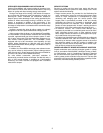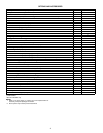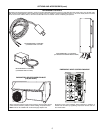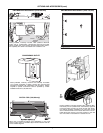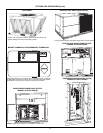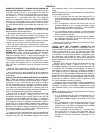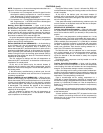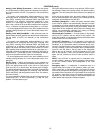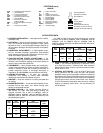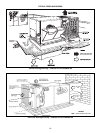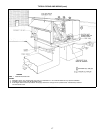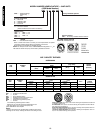11
CONTROLS (cont)
NOTE:
Compressor no. 2 cannot be energized unless there is a
signal for Y2 from the space thermostat.
4. If compressor no. 2 is energized, and the Y2 signal from the
thermostat is satisfied, compressor no. 1 and 2 are deener-
gized. Reasserting Y2 will start compressor no. 1 and (after
a 20-minute interstage delay) compressor 2.
5. If compressor no. 1 is energized and the thermostat is satis-
fied, compressor no. 1, the OFM, and IFM are deenergized
and the EconoMi$er modulates closed.
Heating, Units With Economizer —
Upon a call for heat
through W1, the IFC energizes to start the evaporator fan and
the economizer damper blade opens to the minimum position. If
the accessory two-position damper is used, the outdoor-air
damper opens to the minimum position whenever the evapora-
tor fan runs. If unit is equipped with 2 stages of heat, when addi-
tional heat is needed a call is made through W2.
As space temperature approaches the heating temperature
set point, heating stages cycle off. Economizer or two-position
damper returns to fully closed position.
Defrost (548F036-072 and 549B036-072) —
As frost builds up
on the outdoor coil, the coil temperature drops below 28 F.
When this outdoor-coil temperature drop is sensed by the
defrost thermostat (DFT) and the defrost timer is at the end of a
timed period (adjustable at 30, 50, or 90 minutes), the unit oper-
ates in a defrost cycle controlled by the defrost timer and ther-
mostat. During this cycle, the reversing valve solenoid (RVS) is
energized and the outdoor fan shuts off. The electric heaters (if
installed) will be energized.
The unit continues to defrost until the coil temperature as
measured by DFT reaches 65 F, or the duration of defrost cycle
completes a 10-minute period.
At the end of the defrost cycle, the electric heaters (if
installed) and the reversing valve will be deenergized, and the
outdoor-fan motor will be energized. The unit will now operate in
the Heating mode.
If the thermostat is satisfied during a defrost cycle, the unit
will continue in the Defrost mode until the time or temperature
constraints are satisfied.
Defrost (548F090-120 and 549B090,120) —
When the tem-
perature of the outdoor coil drops below 28 F as sensed by the
defrost thermostat (DFT2) and the defrost timer is at the end of
a timed period (adjustable at 30, 50, or 90 minutes), reversing
valve solenoids (RVS1 and RVS2) are energized and the OFC
is deenergized. This switches the position of the reversing
valves and shuts off the outdoor fan. The electric heaters (if
installed) will be energized.
The unit continues to defrost until the coil temperature as
measured by DFT2 reaches 65 F, or the duration of defrost
cycle completes a 10-minute period.
During the Defrost mode, if circuit 1 defrosts first, RVS1 will
oscillate between Heating and Cooling modes until the Defrost
mode is complete.
At the end of the defrost cycle, the electric heaters (if
installed) will be deenergized; the reversing valves switch and
the outdoor-fan motor will be energized. The unit will now oper-
ate in the Heating mode.
If the space thermostat is satisfied during a defrost cycle, the
unit will continue in the Defrost mode until the time or tempera-
ture constraints are satisfied.
SEQUENCE OF OPERATION — 542J150,180
Cooling, Units Without Economizer —
With unit main power
on, set thermostat to COOL position and desired room temper-
ature. Set fan switch at AUTO. (on demand) or ON (continuous)
position.
On a rise in room temperature, cooling contactor no. 1 in the
thermostat closes. The indoor and outdoor fan motors start. If
the 5-minute compressor time-delay (CTD) on the defrost board
(DB) is satisfied, then compressor no. 1 (542J180) or unloaded
compressor (542J150) contactor is energized and compressor
will start. Compressor cycles on demand of the thermostat to
satisfy room conditions. Each time the cooling contactor no. 1
opens, the CTD starts the 5-minute delay.
On 542J180 units, with an additional rise in room tempera-
ture, cooling contactor no. 2 in the thermostat closes, energiz-
ing compressor contactor no. 2. Compressor no. 2 starts and
cycles on demand of the thermostat to satisfy the occupied
space demands.
On 542J150 units, compressor runs fully loaded on a call for
second-stage cooling.
Cooling, Units With EconoMi$er —
Upon a call for cooling,
when outdoor ambient temperature is above the temperature
control setting, the indoor and outdoor fans and compressor(s)
energize. The economizer damper moves to vent position.
Upon a first-stage call for cooling, when outdoor ambient tem-
perature is below the temperature control setting, the indoor fan
starts and economizer damper modulates to maintain mixed-air
temperature. The compressor(s) remains off.
Upon a second-stage call for cooling, compressor no. 1
(542J180) or loaded compressor (542J150) is energized and
mechanical cooling is integrated with economizer cooling. Com-
pressor no. 2 (542J180) is locked out. If the air temperature is
below 50 F, a cooling lockout switch prevents the compressor(s)
from running.
When supply-air temperature drops below a fixed set point,
the economizer damper modulates to maintain the temperature
at the fixed set point.
A freeze protection thermostat (FPT) is located on the indoor
coil. It detects frost build-up and turns off the compressor(s),
allowing the coil to clear. Once frost has melted, the compres-
sor can be reenergized.



